Back To The Top
Built on the former grounds of Rock Point House the work began in July 1896 when a newly formed company called ‘The New Brighton Tower and Recreation Company Limited’ with a share capital of £300,000 decided to purchase the Rock Point Estate of over 20 acres. The Tower was to be 544 feet high, with Assembly Hall, Winter Gardens, Refreshment Rooms and layout with a cycle track. The Tower was to be more elegant then Blackpool’s. Shares were £1 each and the Architects were to be Maxwell & Turk of Manchester, who designed the Blackpool Tower. The Tower would be made of mild steel. The builders engaged were Handysides & Company of Derby.
On 22nd June 1896 the first piece of turf was cut at the Tower grounds' site and building of the tower started in 1897. Two workmen were killed and a third seriously injured in the January, when a crane lifting a heavy iron girder met with an accident. The hook holding the load gave way. By the April, the Tower was 180 feet and another workman met his death, while in June, a labourer fell to his death down a lift hole. People said there should safety nets around the structure. It rose higher and higher and in the August it claimed another worker. He fell from over 100 feet. A month later, another workman was killed when he fell 60 feet.
The Tower Grounds opened at Whitsuntide, although the Tower itself was not completed. It cost £120,000 to build the Tower, which was completed in 1900. Over 1,000 tons of steel were used in the construction. From the ground to the top of the Cooper Ball on the flag-staff, it measured 567 feet, 6 inches. It was actually 562 feet high itself and 621 feet above sea level, becoming the highest structure in the United Kingdom.
Four lifts took sightseers to the top of the Tower structure at a cost of 6d. From there one could see for miles around including The Isle Of Man, Great Orme's Head and the Welsh Mountains. The Tower attracted a half million people in the year.
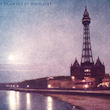 |
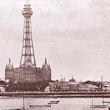 |
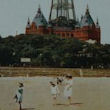 |
|
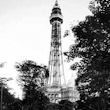 |
 |
%20New%20_Brighton.jpg) |
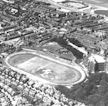 |
 |
 |
 |
 |
 |
 |
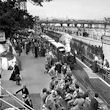 |
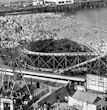 |
 |
 |
 |
 |
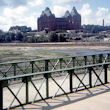 |
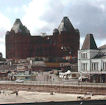 |
 |
 |
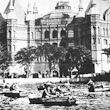 |
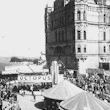 |
 |
 |
The Tower was illuminated at night with fairy lights, as were the grounds. 30,000 red, white and green around the many pathways. Admission to the grounds was a shilling, which included admission to the Ballroom and Theatre.
With the outbreak of World War One in 1914 the public were not allowed to go up to the top of the Tower for military reasons. In the War years the steel structure had been neglected and became rusty through lack of maintenance. The cost of renovating was more then the owners could afford. A Middlesborough company of 'Messrs, Hughes Bolckow& Company' agreed to dismantle the top portion of the structure because of the scrap metal value. They commenced to take it down on 7th May 1919 with a party of 13 men and it was completed by June 1921 without a single mishap. The overhanging platforms were constructed of reinforced concrete and took a great deal of time to dismantle. the brick portion, comprising the Ballroom and Theatre remained, together with the turrets. The steel tower went right down to the foundations and these could be seen in the basement.
The Ballroom was one of the largest in the world, with a sprung floor and dance band stage. The orchestra had as many as 60 players. Big bands played at the Tower, including Bert Yates, Bill Gregson and Victor Sylvester. Other well known artists appeared at the Ballroom including Mae West in November 1945. Well over 1,000 couples could dance without undue crowding. It was decorated in white and gold, with the emblems of various Lancashire towns. The Ballroom had a balcony, with seats to watch the dancers below. Behind this was an open space, where couples used to learn the dance without interfering with the more proficient ones. There was also a fine billiard Saloon with 5 tables. Above the Ballroom there was a Monkey House and Aviary in the Elevator Hall and also a Shooting Gallery.
The Tower Theatre opened on Whit Monday, 30th May 1898 and had seating for for more than 2,000 while in the balcony there was standing room for a further 500. The theatre had the world's largest stage being 45 feet and a depth of 72 feet. Variety was the attraction with Mademoiselle Marguerite with her seven lions and singing fox terriers as top of the bill. There was also a high-wire performer. A special Victory Concert was arranged after the Second World War. The theatre was decorated with all the flags of the Allied Powers and a presentation was made to (Lt.Cdr) Ian Fraser, the town's Victoria Cross holder.
The Tower Gardens had much to offer also. The whole area covered 35 acres. There was a large Japanese Cafe at the lakeside, where the real Gondoliers had Venetian Gondolas. There was also a fountain and seal pond in the old quarry, with its rockery. Then there was the Parisian Tea Garden where one could enjoy a cup of tea and watch the pierrots. Situated in the trees was a restaurant called 'The Rock Point Castle' .
At the Promenade end there was an outdoor dancing platform which could hold over a thousand dancers where also the Military Band played. In the 1960's Tommy Mann had a small railway that ran from the platform at the bottom of the steps and along the other side of the railings and circled the old quarry and back again.
Then there was the Old English Fairground on the higher level which, in later years, became the motor coach park. The Himalayan Switchback Railway was a great favourite, as was the water chute, with the boats traveling at speed into the lake. The Railway had previously been at the Brussels Exhibition.
At the height of the Tower Grounds popularity in the 1950s attractions at the fairground included 'Figure of Eight', 'Wall Of Death', 'Donkey Derby' and 'The Caterpillar'. Also a chair lift was introduced which were small cabins attached to a cable which ran from the amusement park entrance at the promenade end to the top of the brick portion of the Tower.
As there was no winter entertainment the owners of the Tower built adjacent to the Tower Building an Athletic Ground. The centre of the arena was used to stage both football as well as many spectacular events including a Wild West Show from May to October 1908. There was also an inside track used for athletics and a banked track where the World Cycling Championships were held in July 1922. There was even a Stadium with a seating capacity of 8,000 though football matches hardly drew in 1,000 spectators.
In 1896 'New Brighton Tower Football Club' was formed and joined the Lancashire League at the start of the 1897-1898 season. After finishing as champions in their first season, the club was elected to the Second Division of the Football League when the league was expanded from 16 teams to 18 teams in both divisions.
The club signed a number of new players, including some who had played international football, and was reasonably successful, finishing 5th (out of 18) in its first season, and 4th in their third season. However, the cost of maintaining a professional football club became too high for the Tower's owners, and the club was disbanded in the summer of 1901.
A new amateur side was formed soon after called 'New Brighton Tower Amateurs' who would later play at Massey Park whilst Harrowby Football Club became the new tenants of the Athletic Ground and played there for some considerable time.
 |
 |
 |
 |
 |
 |
 |
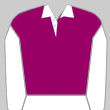 |
 |
 |
 |
 |
 |
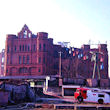 |
 |
 |
 |
 |
 |
%202007a.jpg) |
 |
.jpg) |
.jpg) |
 |
On 28th June 1921, local physician Dr Tom Martlew formed 'New Brighton AFC' (nicknamed 'The Rakers' - a name they got from the days they played at Sandheys Park in Rake Lane) and launched them into the Lancashire League. In 1923 the club was elected to one of the vacancies arising when Division Three (North) was extended to 22 clubs. In 1925 New Brighton AFC achieved their best ever position, finishing third in Division Three (North). They never finished higher than tenth after that and had to seek re-election four times. In 1951 they failed re-election and were replaced by Workington FC.
The club continued to play in non-league competition until 1983, when they were wound up. The current New Brighton club was founded in 1997 and plays in the West Cheshire League at Harrison Park in Wallasey Village. The Tower ground was sold to the Wirral Council for £120,000 in the 1960s after 'The Rakers' had moved to Hoylake
During the Second World War the United States Army was stationed in New Brighton at what was known as Depot 0616 and the Commanding Officer was Colonel Earl Zwingle. The Tower Athletic Ground was taken over as a large military vehicle park where all sorts of large army trucks were kept in readiness for the invasion of France.
After the demise of football at the Athletic Ground a number of greyhound meetings was held in the early 1970's but was not a success and so was replaced by Stock Car Racing (which never actually had planning permission to run). After complaints by local residents the racing was stopped in March 1976. A housing estate now occupies the site of the old athletic ground and stadium.
With the holidaymaker's no longer visiting New Brighton due to cheaper flights abroad and guaranteed better weather the Tower Grounds began to deteriorate. The buildings fell into disuse and began to become an eyesore.
The end came on on 5th April 1969 when a fire engulfed the Tower. The building was dismantled and the site cleared.